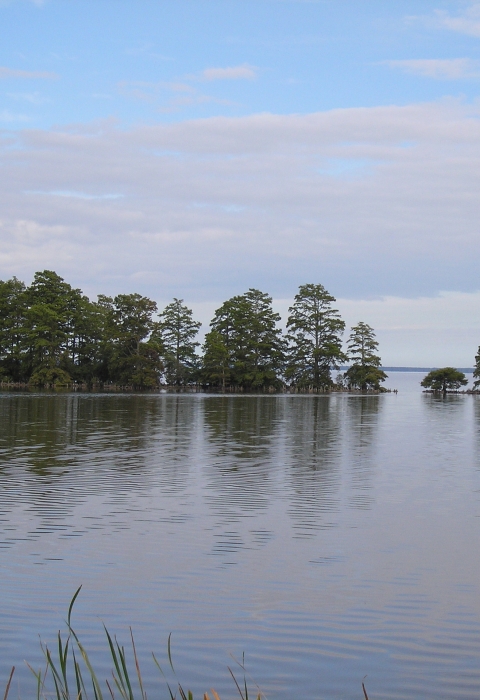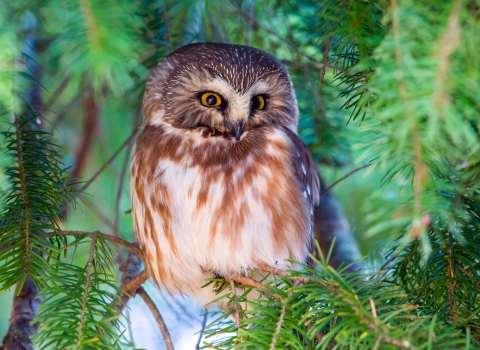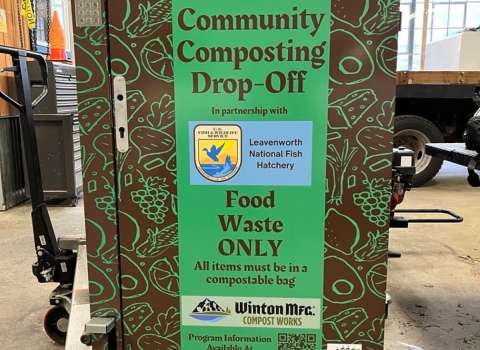Deeply dedicated to our mission to conserve, protect, and enhance fish, wildlife, and plants and their habitats for the continuing benefit of the American people, the U.S. Fish and Wildlife Service (Service, USFWS) and its partners continue to seek opportunities, investigate strategies, and implement measures to improve conditions in Lake Mattamuskeet on Mattamuskeet National Wildlife Refuge (NWR, refuge). To that end, the Service coordinated with the state of North Carolina (including the North Carolina Department of Water Resources and the North Carolina Wildlife Resources Commission), the Lake Mattamuskeet Watershed Restoration Technical Working Group, the University of North Carolina Institute of Marine Sciences, and other interested parties to develop an Environmental Assessment (EA) to evaluate a pilot study to treat cyanobacteria in Lake Mattamuskeet at Mattamuskeet NWR in Hyde County, North Carolina. The pilot study supports the refuge’s Comprehensive Conservation Plan (USFWS 2008) and Habitat Management Plan (USFWS 2018) and supports the Lake Mattamuskeet Watershed Restoration Plan (North Carolina Coastal Federation 2019) by seeking to improve water quality and clarity within Lake Mattamuskeet.
Lake Mattamuskeet is a 40,276-acre lake that dominates the 50,180-acre refuge. The Service is dedicated to management of the lake to support wildlife, including birds, fish, and invertebrates. Due to excess sediment and nutrients flowing into the lake from the surrounding landscape, reduced flow to Pamlico Sound, and an overabundance of invasive common carp (Cyprinus carpio), lake conditions began to decline in the early 1990s with declining water quality and clarity and increasing turbidity. Necessary to support lake health and serve wildlife needs, submerged aquatic vegetation (SAV) also declined to the point that, by 2017, Service staff were unable to locate a single plant. The SAV was the primary food source for wintering waterfowl in the area, historically providing over 34 million energy use days of forage. Collectively, annual wintering waterfowl populations on the lake would sometimes exceed 200,000 ducks, geese, and swans. In 2020, during a revision to update waterfowl objectives for the refuge, calculations determined that the absence of SAV and associated invertebrates and seeds in the lake, compared to values from the literature, resulted in the lake’s loss of over 20 million energy use days for waterfowl.
Recognizing the seriousness of the situation, the Service continues to work with partners to research and recommend solutions for improving conditions in the lake and watershed. Recently, the Lake Mattamuskeet Watershed Restoration Technical Working Group was successful with the award of a $1 million Large Invasive Species Grant for the removal of carp from Lake Mattamuskeet. The North Carolina Coastal Federation was successful in being awarded a Regional Conservation Partnership Program grant from the Natural Resources Conservation Service to reduce sedimentation and nutrient transfer to the lake. The refuge is also exploring other possible projects within the refuge that could reduce sediments entering the lake or otherwise help improve water quality. As another potential tool to address these shared concerns, the Service evaluated the pilot study considered in the EA, for a treatment of cyanobacteria also known as blue-green algae. The treatment would use a sodium percarbonate-based algaecide, Lake Guard® Oxy, in 4 bays on ~400 acres, or 1% of Lake Mattamuskeet.
In September 2023, the Service requested public review and comment on the draft EA for the proposed pilot study. The Service received comments from 6 state agencies, the Catawba Indian Nation, several organizations, and 230 individuals. The Service thoroughly reviewed all comments received in development of the final EA. In response, the Service updated the final EA to provide clarifications and additional information, including the listed items.
- Added clarification that the method of application of Lake Guard® Oxy will be by boat only.
- Added details on restrictions limiting the timing of application to periods of low or no waterfowl abundance to minimize potential impacts on waterfowl.
- Added more detail on requiring continuous observations during pilot study treatments to monitor potential wildlife response.
- Added clarification regarding hazing of birds during pilot study treatments to minimize adverse impacts.
- Added bird toxicity testing results.
- Added clarification regarding the scope of the action and potential adverse and beneficial impacts.
With these added clarifications to the existing measures outlined in the draft EA, the Service has incorporated restrictions to application of Lake Guard® Oxy during the pilot study trial treatment to minimize and avoid potential negative impacts on wildlife and the ecosystem. The potential beneficial effects of the pilot study in the treated bays would include a temporary increase in water clarity as a result of reduced levels of cyanobacteria and cyanotoxins for five to seven weeks in the pilot study area following each treatment and a potential increase in beneficial phytoplankton communities, such as beneficial green algae. The results of this pilot study treatment and its impact on increasing water clarity would be influential in the efforts to restore SAV to the lakebed, which would provide essential habitat for fish and other aquatic life and an important food source for waterfowl.
Given the limited scope of the project at 400 acres (1% of the lake), the pilot study nature of the action, measures included to minimize impacts, the included Monitoring Plan, and the analysis in the EA and Section 7 Section 7
Section 7 Consultation
The Endangered Species Act (ESA) directs all Federal agencies to work to conserve endangered and threatened species and to use their authorities to further the purposes of the Act. Section 7 of the Act, called "Interagency Cooperation," is the mechanism by which Federal agencies ensure the actions they take, including those they fund or authorize, do not jeopardize the existence of any listed species.
Learn more about Section 7 which find no significant beneficial or adverse impacts, the Service finds that a Finding of No Significant Impact (FONSI) is the appropriate next step and an Environmental Impact Statement is not warranted. The final EA and FONSI only authorize the pilot study with the application of Lake Guard® Oxy limited to 4 bays.
The Service intends to implement the pilot study in April 2024 with monitoring by the Service, BlueGreen Water Technologies, and the University of North Carolina. Results of these monitoring efforts will be reviewed to better understand the beneficial and adverse impacts, the effectiveness of measures to minimize impacts, the effectiveness to control cyanobacteria, and lake and wildlife responses. If this tool is determined to be successful, any future consideration of its use on the refuge would be required to meet all applicable laws, regulations, and policies, including the National Environmental Policy Act and other compliance and permitting requirements.
The final EA for the pilot study, including the Service’s Response to Comments Appendix and the FONSI, is available at the link below.
Final Environmental Assessment
A factsheet is also available for additional information.
Refuge Manager Kendall Smith is available to answer any additional questions or provide additional information.
References:
North Carolina Coastal Federation. 2019. Lake Mattamuskeet Watershed Restoration Plan and Addendum. https://www.nccoast.org/protect-the-coast/stormwater/lake-mattamuskeet-watershed-restoration/
U.S. Fish and Wildlife Service. 2008. Mattamuskeet National Wildlife Refuge Comprehensive Conservation Plan. National Wildlife Refuge System, Southeast Region, U.S. Fish and Wildlife Service, U.S. Department of the Interior. December 2008. Atlanta, GA. https://ecos.fws.gov/ServCat/Reference/Profile/20310
U.S. Fish and Wildlife Service. 2018. Habitat Management Plan for Mattamuskeet National Wildlife Refuge. National Wildlife Refuge System, Southeast Region, U.S. Fish and Wildlife Service, U.S. Department of the Interior. June 2018. Swan Quarter, NC. https://ecos.fws.gov/ServCat/Reference/Profile/103270



